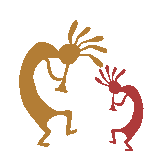|
Start This Feature At
Its Beginning |
|
|
about the cave
The only painting of a human form depicts a bird-headed man, possibly a
shaman, falling away from a bull he appears to have wounded with a spear.
You can see a picture of this figure at the official Lascaux web site of the
Ministry of Culture of the French government (see BACK page). Other well-known groups of figures in the cave include the Swimming Deer, a
herd of horned deer shown in profile.
The scale of the paintings suggests that the artists must have used ladders
and scaffolding, and archaeologists have discovered sockets for scaffolding
beams in the walls of the cave. they also have found charcoal, lamps, spear
points, pigments, and engraving tools on the floor.
Analysis of the charcoal and other organic materials suggests that the cave
was in use from about 15,000 BCE to as late as 9000 BCE. Most of the artwork
seems to date from the earliest part of this period. Archaeologists believe
that although Stone Age people visited the cave for rituals; they did not
live there.
There are many theories that attempt to explain the purpose and symbolic
meaning of the art, but none that are agreed upon by scholars, who are still
investigating the figures.
The paintings have deteriorated since the cave was opened to the public in
1948 because the hundreds of thousands of visitors disturbed the delicate
balance of its environment. Prior to its opening, the stable moisture and
temperature in the cave were ideal for preservation of the pigments over the
many thousands of years since it was abandoned. Once opened to visitors,
however, colors began to fade and green fungus grew over the pigments. So
bad was the deterioration, the cave was closed in 1963 and a replica of the
cave, known as Lascaux II, was constructed using the pigments and methods
believed to have been used by the original artists. Today, visitors tour
this replica.




